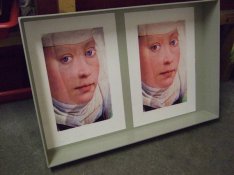I am quite pleased to learn that you have had some success making tri-color diazostilbene carbons. Could you share some info (or even a foto or two) on your procedures? What kind of separation negative (con-tone/half-tone - silver/inkjet) are you using?
Best,
Charles
Hi Charles,
Yes, I am pleased with these tests too! They went rather well.
As I wrote earlier I found the 4,4'diazidostilbene here in the Netherlands at about €1,10 (= $1,36) per gram. Rather expensive compared to dichromate, but not a real show stopper.
I used the Kremer color pastes and a Gelita photo gelatin, restauration quality (of bovine origin) in a 10% solution. Added 30gr sugar and 3ml glycerine per liter.
Coating was on 200gr Yupo with a RD200 coating rod.
My color balance was a bit off, the Kremer M is very powerfull so I need to cut that down next tissue pouring session.
Diazidostilbene/gelatin ratio in my mix is 0.06 (6 gr per 100gr gelatin). I followed more or less your recommendations above. Printing time is a little bit longer than with my usual 3% dichromate. I used the same time for all colors.
I transfered the A3+ prints (K=>C=>M=>Y) to an albumen coated polycarbonate sheet and used an (ebay acquired) kodak register punch. The albumen really helped, but unfortunately reintroduced some dichromate again. I will experiment with other albumen hardeners (alcohol?) and other coatings. Until now I tried fully hydrolyzed PVA (Mowiol 4-98) but without succes. Washing the transfered print with the albumin subcoating is much much easier than without!
I print digital negatives with QuadToneRip on an Epson 7890 on Sihl film. I use a custom QTR profile with partioned PK, LK, LLK and Y as a UV blocking toner ink. Curve was calculated with Charthrob. I also experimented with Icefields to generate a stochastic set of negatives. But outputting them well on the epson needs a dedicated rip. I did not try imagesetter output of these yet. In my opinion the QTR inkdot dithering allready behaves as a stochastic halftone in it's nature.
Here's a tray snapshot of the first two, still wet, and a bit too magenta. These are part of a series of portaits I'm working on - based on merged contemporary and historic faces.

regards,
Kees



 OzJohn
OzJohn
